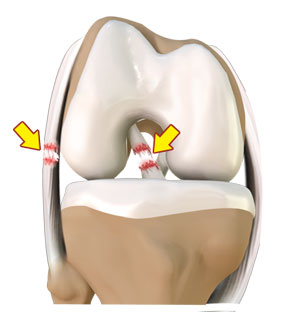
Multiligament knee injuries are a challenging and complex problem. A multiligament knee injury is established when at least two of the four major knee ligaments are torn. Multiple ligaments allow for multidirectional movement. Multidirectional instability is a primary symptom of multiligament damage.
Multiligament knee injuries are common, and potentially disabling. In addition, there is high incidence of injury to the meniscus and cartilage when multiple knee ligaments are injured.
What causes multiligament injuries?
Knee dislocations often result in multiligament knee injuries, usually involving rupture of the Anterior Cruciate Ligament (ACL) and Posterior Cruciate Ligament (PCL). Up to 52% of patients with multiple ligament injuries also have medial collateral (MCL) and lateral collateral ligament (LCL) damage. PCL injuries are associated with blood vessel damage, and only 28% of PCL injuries occur alone. Thus, when a PCL injury is identified, there is a high level of suspicion that multiple ligaments are also injured. Knee dislocations can also cause serious complications involving the nerves and blood vessels in the leg.
Knee dislocation can result from high-energy trauma due to auto accidents, a fall from a high place, direct blows to the knee in contact sports, and rapid changes in direction that are involved in cutting and pivoting during sports activities. Studies report that 50% of knee dislocations are caused by a high-energy impact, and 50% are due to sports-related activities.
What are the symptoms of knee ligament injuries?
Symptoms of multiple knee ligament injuries include:
- pain, swelling, and impaired range of motion
- injuries to the nerves and blood vessels, and
- nee instability.
How are multiligament knee injuries diagnosed?
A thorough history, clinical examination with stress x-rays, and MRI are critical to identifying all injured structures. Comprehensive clinical evaluation and imaging analysis will include evaluation of nerves, blood vessels, cartilage and the meniscus. A diagnostic arthroscopy may be required to evaluate and diagnose these injuries.
What is the treatment?
When the tears are small or partial, a trial of conservative treatment with rest, ice, compression and elevation may be recommended. But, complete tears of multiple ligaments will require surgery.
Studies report that surgical treatment and postoperative rehabilitation provide the best outcome for patients. Only when a patient is of advanced age, immobile and/or has comorbidities is nonsurgical treatment considered.
Surgical Reconstruction
Multiligament surgical reconstruction is favored over ligament repair because it provides better outcomes and a reduced risk of repeat surgeries. Reconstruction is recommended for early mobilization and to avoid joint stiffness. Studies also report that reconstruction of all injured ligaments at the same time, is the best approach to avoid the risk that the damaged ligaments can stiffen, thicken and scar. However, surgical reconstruction may be done in stages or with multiple surgeries.
Immediate surgical reconstruction soon after the injury is preferred. In some cases, a vascular surgeon or microsurgeon may be called in.
The surgical technique employed will be specific to each patient’s needs. The surgery may be open or arthroscopic, or Dr. Stark may employ a combination of these. Surgery involves removal of the damaged ligaments and replacement with graft(s).
There are many difficult decisions that must be made when dealing with multiple ligament injuries. Dr. Stark will choose the most biomechanically and clinically validated anatomic ligament reconstruction available.
Recovery
Rehabilitation is essential to ensure a good functional outcome. For the first six to eight weeks after surgery, crutches will be necessary. Recovery from complex knee surgery requires 9-12 months of post-op rehabilitation before returning to full activities to decrease the risk that a graft may fail. The good news is that most patients can return to high level sports after full recovery.
Dr. Stark has office in Carlsbad.
Related Topics
- Anterior Cruciate Ligament (ACL) Tear/Reconstruction
- Knee Replacement (Partial and Total Knee Replacement)
- Collateral Ligament (MCL / LCL) Tear/Reconstruction
- Meniscus Tear/Repair
- Multi-Ligament Injuries
- Patellar/Knee Cap Instability
- Posterior Cruciate Ligament (PCL) Tear/Reconstruction
- Tendon Ruptures (Patella Quad Tendon Hamstring)
- Trochleoplasty
